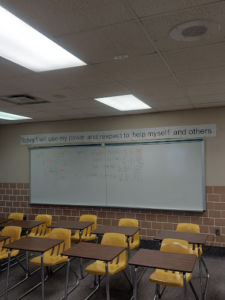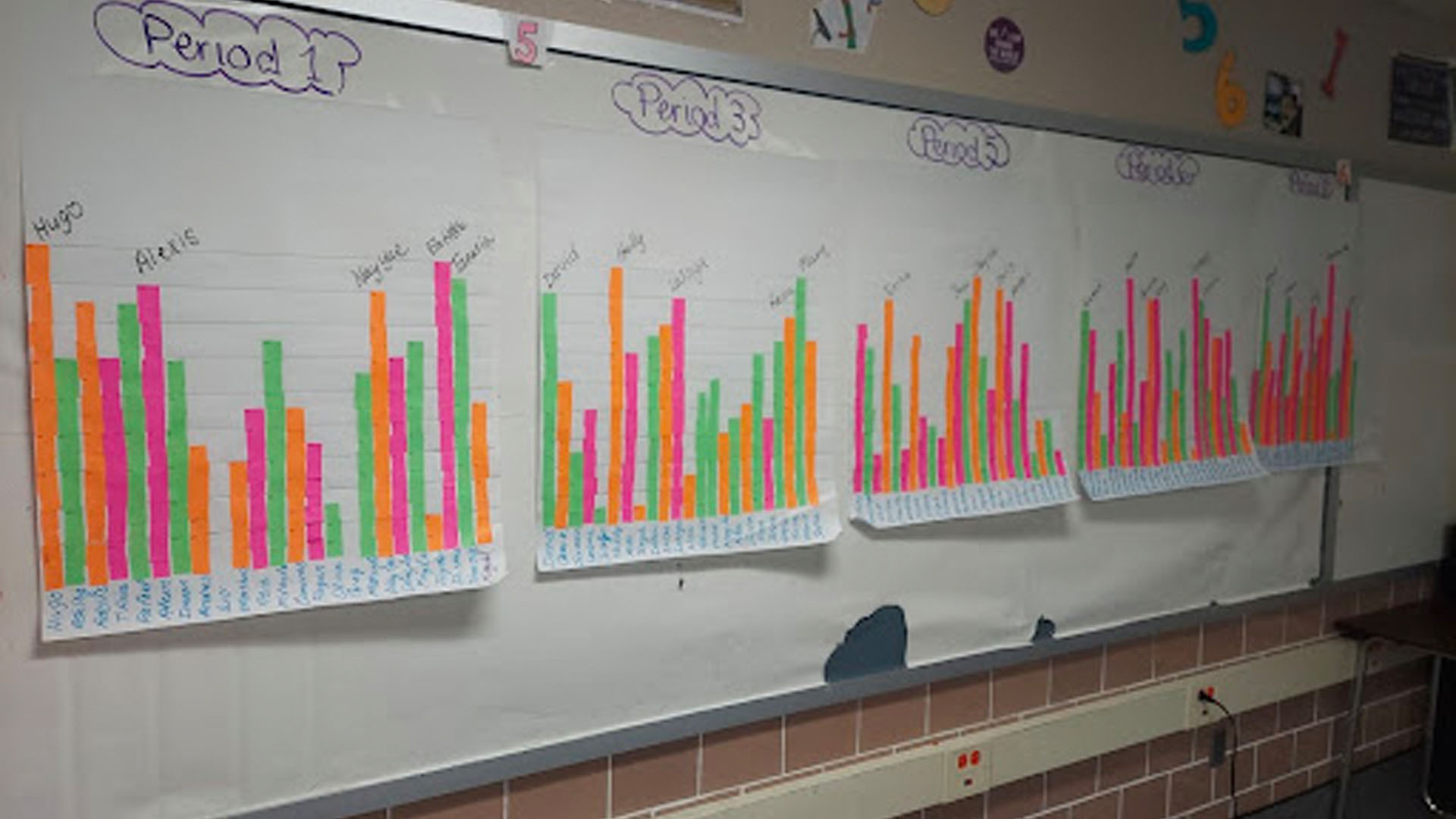Recently the topic of discussion with a friend was how often we as teachers experience failure. Try though we might, test scores are never really where we want them. Students who were doing well before we met them continue to do so, just as students not faring well, seem to continue in the same trajectory. I longed for things to be different. So, this year I instituted a major change. I decided what my students needed most was to learn how to think through challenging math problems, and I wasn’t wrong. Armed with Peter Liljedahl’s 2021 text Building Thinking Classrooms and the pain and frustration of the social upheaval and pandemic deaths of recent years, I set out to push the boundaries of my abilities to teach math and help students realize more of their true potential. In a whirlwind of change, in society at large, and in my own life, I departed from the status quo, as much as I could (read about the beginning of the journey & a stop along the path). How did I fare? Did transformation take place?
I set out to push the boundaries of my abilities to teach math and help students realize more of their true potential.
 As I write, we are in the middle of iLearn testing. Our daily schedule has been turned upside down and classrooms transfigured into secure test environments as students seek to match their developing academic skills to the demands of high stakes testing. Across one wall of my room, outside the immediate eyeshot of testers, are a series of posters touting time on task for an intervention program that is part of a new curriculum. To further help our students meet the demands of testing, my school district is undergoing math textbook adoption. Around mid-year, my PLC team and I agreed to pilot the new curriculum. Liljedahl (p. 25-30) provides great insight into how best to use rich tasks appropriate for a Thinking Classroom with a curriculum. Curriculum tasks direct students to the use of specific skills outlined in math standards, whereas rich tasks are purposefully open-middle or open-ended to challenge students to think for themselves of any method they can to solve problems. To keep students thinking when there is a curriculum to follow, Liljedahl recommends introducing a new topic with a review-based question, then asking a question that can extend students’ knowledge of the topic and get them thinking. In other words, use a related rich task which can get students to think about the topic in different ways before revealing to students a procedure to address the problem or the expectations of the standard. For example, when teaching solving equations, this year I started off with rich tasks on the meaning of equivalency and used shapes with numbers instead of variables. Gradually, we began to use variables, and eventually discussed more traditional concerns when solving equations, such as inverse operations. Students knew though, that if necessary, they could use equivalency, shapes, or any other method they chose to solve equations. How did I fare overall? With a few weeks left in the school year, I’ve made it, and my students have too! We are all wiser and better prepared thanks to the experiences we took on this year. My advice to other math teachers seeking to rise above the status quo is to consider using rich tasks which can make your students think about the math they are learning. While you will need to be persistent in the beginning to gain student buy-in, you will see improvements in student confidence, engagement, and curiosity about math. Further, don’t go it alone. Get as many teachers trying Building Thinking Classrooms with you as you can. I started out as the only teacher I knew using the methodology. Hopefully with this blog and given more time, others will try it also.
As I write, we are in the middle of iLearn testing. Our daily schedule has been turned upside down and classrooms transfigured into secure test environments as students seek to match their developing academic skills to the demands of high stakes testing. Across one wall of my room, outside the immediate eyeshot of testers, are a series of posters touting time on task for an intervention program that is part of a new curriculum. To further help our students meet the demands of testing, my school district is undergoing math textbook adoption. Around mid-year, my PLC team and I agreed to pilot the new curriculum. Liljedahl (p. 25-30) provides great insight into how best to use rich tasks appropriate for a Thinking Classroom with a curriculum. Curriculum tasks direct students to the use of specific skills outlined in math standards, whereas rich tasks are purposefully open-middle or open-ended to challenge students to think for themselves of any method they can to solve problems. To keep students thinking when there is a curriculum to follow, Liljedahl recommends introducing a new topic with a review-based question, then asking a question that can extend students’ knowledge of the topic and get them thinking. In other words, use a related rich task which can get students to think about the topic in different ways before revealing to students a procedure to address the problem or the expectations of the standard. For example, when teaching solving equations, this year I started off with rich tasks on the meaning of equivalency and used shapes with numbers instead of variables. Gradually, we began to use variables, and eventually discussed more traditional concerns when solving equations, such as inverse operations. Students knew though, that if necessary, they could use equivalency, shapes, or any other method they chose to solve equations. How did I fare overall? With a few weeks left in the school year, I’ve made it, and my students have too! We are all wiser and better prepared thanks to the experiences we took on this year. My advice to other math teachers seeking to rise above the status quo is to consider using rich tasks which can make your students think about the math they are learning. While you will need to be persistent in the beginning to gain student buy-in, you will see improvements in student confidence, engagement, and curiosity about math. Further, don’t go it alone. Get as many teachers trying Building Thinking Classrooms with you as you can. I started out as the only teacher I knew using the methodology. Hopefully with this blog and given more time, others will try it also.
My advice to other math teachers seeking to rise above the status quo is to consider using rich tasks which can make your students think about the math they are learning.
 It’s been a long, hard year. The trauma we experienced is not forgotten, but neither is it ahead of us. We are ready to put it behind us now. In moments when we think of what we’ve gone through, we can take in a deep breath and let out a collective sigh. Our classroom mantra for this year was, “Today I will use my power and respect to help myself and others”. My students started out uncertain 8th graders. As our time together comes to an end, they are emerging sure-footed 9th graders. Taller, some with deeper voices, and new interests. A transformation takes place every year. This year we used Building Thinking Classrooms to create a bridge to understanding and a new curriculum. The academic transformation that took place was in forging ground we didn’t know existed and coming out the otherside. Reference: Liljedahl, Peter, et al. Building Thinking Classrooms in Mathematics, Grades K-12: 14 Teaching Practices for Enhancing Learning. Corwin Mathematics, 2021.
It’s been a long, hard year. The trauma we experienced is not forgotten, but neither is it ahead of us. We are ready to put it behind us now. In moments when we think of what we’ve gone through, we can take in a deep breath and let out a collective sigh. Our classroom mantra for this year was, “Today I will use my power and respect to help myself and others”. My students started out uncertain 8th graders. As our time together comes to an end, they are emerging sure-footed 9th graders. Taller, some with deeper voices, and new interests. A transformation takes place every year. This year we used Building Thinking Classrooms to create a bridge to understanding and a new curriculum. The academic transformation that took place was in forging ground we didn’t know existed and coming out the otherside. Reference: Liljedahl, Peter, et al. Building Thinking Classrooms in Mathematics, Grades K-12: 14 Teaching Practices for Enhancing Learning. Corwin Mathematics, 2021.
Resources
Please login or register to claim PGPs.
Alternatively, you may use the PGP Request Form if you prefer to not register an account.



